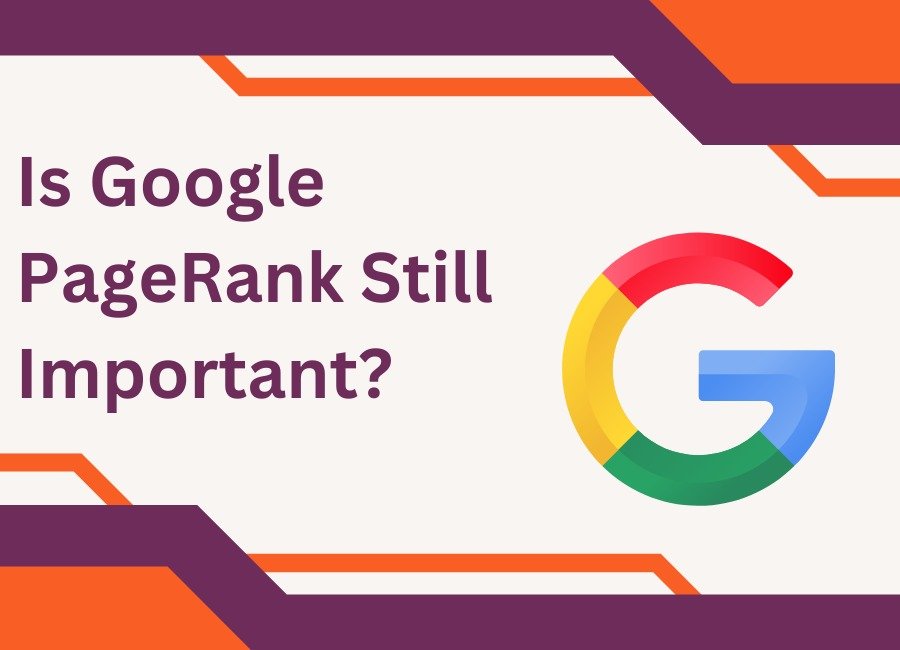Google PageRank is one of the earliest and most important innovations that made Google the dominant search engine. Developed by Google’s co-founders Larry Page and Sergey Brin while they were Ph.D. students at Stanford University, PageRank changed how web content was ranked—based not just on keywords, but on the quality and quantity of links pointing to a page.
Even though the original PageRank toolbar is no longer active, the concept still heavily influences modern SEO strategies. In this article, we’ll break down what Google PageRank is, how it works, and why it’s still relevant in today’s SEO landscape.
What is Google PageRank?
PageRank is a link analysis algorithm that measures the importance of web pages based on the number and quality of inbound links. It was named after Larry Page, not just because he co-invented it, but also as a play on the term “web page.”
The basic idea is simple:
If a page is linked to by many other high-quality pages, it’s likely to be important and should rank higher in search results.
PageRank doesn’t just count links—it evaluates the authority of the linking pages as well.
How Google PageRank Algorithm Works
The PageRank algorithm assigns a numerical value (between 0 and 10 in the early toolbar version) to every webpage. The higher the number, the more authoritative and trustworthy that page is.
Here’s a simplified formula:
PR(A) = (1 – d) + d(PR(T1)/C(T1) + … + PR(Tn)/C(Tn))
Where:
PR(A) is the PageRank of page A
d is a damping factor (usually set to 0.85)
T1 to Tn are pages linking to page A
C(Tn) is the number of outbound links on page
A Brief History of PageRank
1996: PageRank was developed by Larry Page and Sergey Brin at Stanford.
1998: It became the foundation of Google Search when the company launched.
2000: Google released the PageRank Toolbar for Internet Explorer, allowing users to view a web page’s score (from 0 to 10)
2013: Google stopped updating the public PageRank scores.
2016: Google officially retired the PageRank Toolbar.
Though the toolbar was removed, the internal use of PageRank continues to evolve and is still a part of Google’s core algorithm.
Why PageRank Was Revolutionary
Before PageRank, search engines primarily relied on keyword density. That meant webmasters could stuff a page with keywords and rank easily—even if the content was poor.
PageRank changed the game by introducing link-based authority:
- It emphasized quality over quantity.
- Pages with links from credible sources ranked higher.
- It penalized spammy, manipulative link practices.
Is PageRank Still Used by Google Today?
Yes, but it’s no longer the only ranking factor—and it’s no longer transparent to users. Google has confirmed that:
“We use PageRank internally, along with hundreds of other signals to determine search rankings.”
PageRank in Today’s SEO
Modern SEO now includes:
Relevance
User experience
Mobile optimization
Content quality
Core Web Vitals
E-E-A-T (Experience, Expertise, Authoritativeness, Trustworthiness)
PageRank is still a foundational layer—especially when it comes to evaluating link authority.
.
SEO Impact: Why PageRank Still Matters
Even though PageRank isn’t public anymore, the concept of link authority remains at the heart of Google’s algorithm. Here’s how it impacts modern SEO:
1. Backlinks Are Still King
High-quality backlinks from relevant and trusted sources boost a site’s authority. This aligns directly with the principles of PageRank.
2. Internal Linking Helps Spread Authority
You can pass PageRank within your own site by linking strategically between pages. For example, linking from your homepage to new content can help Google discover and value it more quickly.
3. Avoid Low-Quality or Spammy Links
Google’s Penguin algorithm penalizes unnatural links, echoing the original PageRank ethos: not all links are equal.
4. Build Topic Authority
Modern PageRank likely evaluates semantic relevance, rewarding sites that have a well-structured network of related content and backlinks.
Why Google Retired the PageRank Toolbar
- The public PageRank score was misused by SEO practitioners. Many webmasters:
- Bought and sold backlinks based on PR score
- Focused only on numerical metrics, ignoring content quality
- Engaged in link farming and manipulative practices
Google retired the toolbar to reduce spam and encourage more ethical SEO strategies.
Updated Patents & Evolution
Although the original PageRank algorithm is public, updated patents and internal systems are confidential. Google continues to use modified versions of PageRank, including concepts like:
- Topic-sensitive PageRank
- Personalized PageRank
- Seed-based trust systems
These variations help make results more relevant, localized, and resistant to spam.
How to Build Authority in the Post-Toolbar PageRank Era
Want to improve your SEO with the spirit of PageRank in mind? Focus on these:
Create Link-Worthy Content
Offer value, original insights, data, and visual assets that others naturally want to link to.
Earn Backlinks from Authoritative Sources
Get featured on reputable sites, news platforms, or niche blogs with high domain authority.
Strengthen Internal Linking
Use strategic internal linking to pass authority to key pages and improve site structure.
Audit Toxic Links
Use tools like Google Search Console or Ahrefs to disavow low-quality backlinks.
When and why Google PageRank was discontinued
In 2005, Google acquired the full rights to the PageRank patent from Stanford University by issuing 1.8 million shares. This move hinted that Google intended to preserve and further develop the algorithm. However, in 2006, the company quietly replaced the original PageRank with a more advanced version. While the new algorithm retained the same core principles, it featured faster computation and improved resistance to manipulation.
Despite the shift, Google continued to support and update the original PageRank until 2013. That same year, the Penguin algorithm was introduced to further combat manipulative link practices. By 2016, the public-facing PageRank Toolbar was officially discontinued, cutting off access for webmasters to view their scores.
The final confirmation came in 2019 when the original PageRank patent expired, closing the chapter on its legacy. Since then, Google has relied on a modernized version of PageRank, which now works in conjunction with Penguin to evaluate link quality and authority in a more sophisticated and qualitative manner.
.
Why Did Google Retire The PageRank Toolbar?
The Google Toolbar was launched in 2000 to help webmasters track their PageRank scores, offering a score between 0 to 10 based on Google’s link analysis. It became a popular SEO tool for tracking competitors and backlink performance.
However, while it was useful for many, it also gave black hat SEO users an edge. They used the data to reverse-engineer Google’s ranking system and build spammy backlink strategies.
Over time, this made the tool more harmful than helpful. As a result, Google officially discontinued the PageRank Toolbar in 2016 to prevent further manipulation of its algorithm and protect the integrity of search results.
How is PageRank calculated?
Nobody outside Google knows the exact formula behind today’s version of PageRank—it’s a closely guarded secret to prevent manipulation. However, the original concept still gives us clues. PageRank works by analyzing the quantity and quality of links pointing to a webpage. It assigns each page a score between 0 and 10, with new sites starting at a base level (once estimated around 0.25). The score is influenced by how many pages link to it and how valuable those linking pages are. For example, if three different websites link to a page (let’s call it Z), the PageRank of Z is calculated based on the PageRank of each referring page, divided by how many links they’re sharing. So, if sites W, X, and Y each link to Z, their individual link values are split and passed on to Z, combining into a final score. In a simplified model, this might give Z a total PageRank of 0.333.
Conclusion
PageRank, named after both web pages and its co-creator Larry Page, was a groundbreaking algorithm that changed how search engines rank content. It assigns a numerical value—called a PageRank score—based on the number and quality of links pointing to a page.
Although the original PageRank toolbar is now a thing of the past, its core principles still play a major role in how Google evaluates and ranks websites today. Whether you’re building your brand, creating valuable content, or earning backlinks, you’re still operating within the modern framework of PageRank.
To succeed in SEO today, focus on earning high-quality backlinks, building trust with your audience, and providing meaningful value. Do that consistently, and the power of PageRank will naturally work in your favor.
FAQ
Google PageRank works by analyzing the number and quality of links pointing to a webpage. Each link to a page is seen as a “vote” of confidence. However, not all votes are equal—links from high-authority pages carry more weight. The algorithm distributes a value (PageRank score) from one page to another, depending on how many links it gives out and how authoritative it is.
In simple terms:
More quality links = Higher authority
The fewer links a page gives out, the more value each link passes
It’s not just quantity, but also quality and context that matter
Google PageRank is calculated by evaluating the number and quality of links pointing to a webpage. The formula distributes PageRank based on the authority of linking pages and the number of links they have. Higher quality links pass more value, and the calculation iterates until values stabilize. It’s a key factor in determining search rankings.
A good PageRank score is higher than 5, indicating strong authority and visibility.
For better results, consider consulting an SEO company in Mumbai to improve your site’s backlink profile and SEO strategy.








